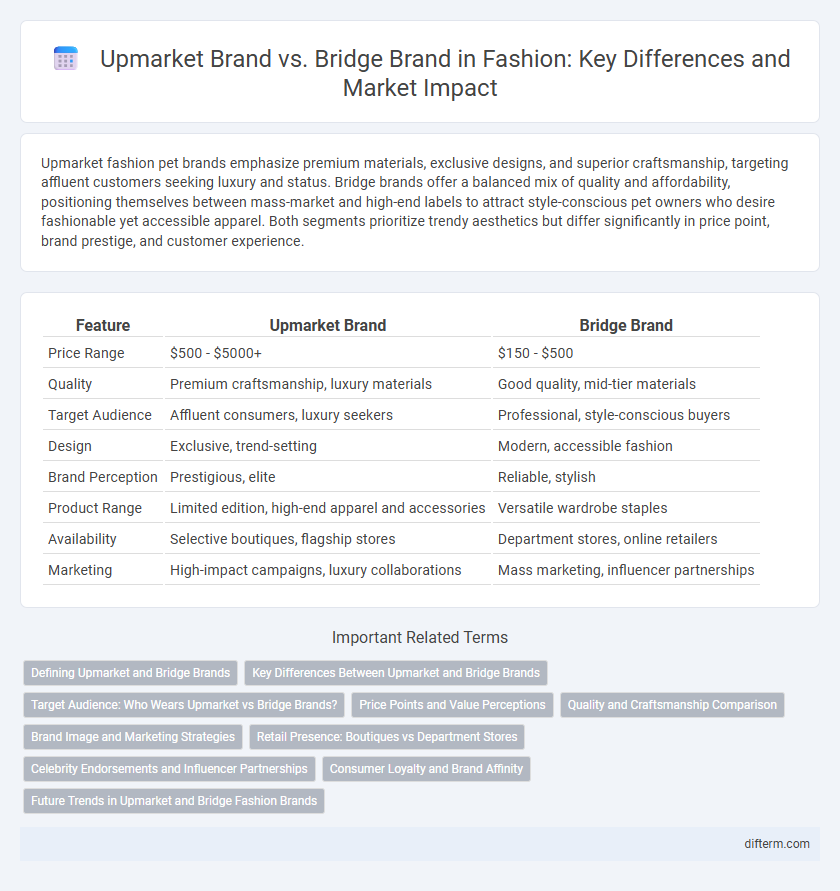Upmarket fashion pet brands emphasize premium materials, exclusive designs, and superior craftsmanship, targeting affluent customers seeking luxury and status. Bridge brands offer a balanced mix of quality and affordability, positioning themselves between mass-market and high-end labels to attract style-conscious pet owners who desire fashionable yet accessible apparel. Both segments prioritize trendy aesthetics but differ significantly in price point, brand prestige, and customer experience.
Table of Comparison
| Feature | Upmarket Brand | Bridge Brand |
|---|---|---|
| Price Range | $500 - $5000+ | $150 - $500 |
| Quality | Premium craftsmanship, luxury materials | Good quality, mid-tier materials |
| Target Audience | Affluent consumers, luxury seekers | Professional, style-conscious buyers |
| Design | Exclusive, trend-setting | Modern, accessible fashion |
| Brand Perception | Prestigious, elite | Reliable, stylish |
| Product Range | Limited edition, high-end apparel and accessories | Versatile wardrobe staples |
| Availability | Selective boutiques, flagship stores | Department stores, online retailers |
| Marketing | High-impact campaigns, luxury collaborations | Mass marketing, influencer partnerships |
Defining Upmarket and Bridge Brands
Upmarket brands in fashion are characterized by premium quality materials, exclusive designs, and higher price points aimed at affluent consumers seeking luxury and status. Bridge brands occupy the middle market, offering a blend of accessible luxury and quality that bridges mass-market and upmarket segments, often appealing to aspirational customers. Both brand types leverage distinct positioning strategies to target different consumer demographics while maintaining brand prestige and desirability.
Key Differences Between Upmarket and Bridge Brands
Upmarket brands emphasize exclusivity, premium pricing, and high-quality materials, targeting affluent consumers who seek luxury and status. Bridge brands occupy the middle market by offering a balance between affordability and quality, often appealing to aspirational buyers who desire stylish trends without the high cost. Key differences include brand positioning, price points, target demographics, and marketing strategies that reflect their distinct market segments.
Target Audience: Who Wears Upmarket vs Bridge Brands?
Upmarket brands attract affluent consumers seeking exclusivity, luxury materials, and high-status fashion statements, often prioritizing craftsmanship and brand heritage. Bridge brands target middle-to-upper-middle-class buyers desiring premium quality and contemporary style without the ultra-luxury price tag, offering accessible sophistication. The distinct audience segmentation reflects differing purchasing motivations: status and exclusivity for upmarket versus value-driven luxury and practicality for bridge brands.
Price Points and Value Perceptions
Upmarket fashion brands typically command higher price points due to premium materials, craftsmanship, and exclusive designs, fostering strong value perceptions among luxury consumers. Bridge brands occupy a middle ground by offering quality products at moderate prices, appealing to customers seeking a balance between affordability and prestige. The perceived value in upmarket brands centers on status and exclusivity, while bridge brands emphasize accessible luxury and practical sophistication.
Quality and Craftsmanship Comparison
Upmarket fashion brands emphasize exceptional quality, using premium materials and meticulous craftsmanship that ensures durability and unique design details. Bridge brands strike a balance between quality and affordability, offering well-made products with refined finishes but often utilizing more cost-effective materials and production methods. Both segments prioritize craftsmanship, yet upmarket brands maintain higher standards through artisanal techniques and exclusive fabric selections.
Brand Image and Marketing Strategies
Upmarket brands emphasize exclusivity and luxury through high-quality materials, limited editions, and prestigious collaborations, crafting a sophisticated brand image that appeals to affluent consumers. Bridge brands balance quality and accessibility by blending premium elements with wider market appeal, positioning themselves as attainable luxury to attract aspirational buyers. Marketing strategies of upmarket brands rely heavily on elite endorsements and selective retail presence, while bridge brands use targeted advertising and accessible price points to broaden customer reach.
Retail Presence: Boutiques vs Department Stores
Upmarket fashion brands typically establish exclusive retail presence through standalone boutiques, offering a curated, immersive shopping experience that reinforces their luxury status. Bridge brands, positioned between mass-market and luxury, often rely on department store placements to reach a broader audience while maintaining an aspirational appeal. Boutiques provide personalized service and brand storytelling essential for upmarket labels, whereas department stores offer high foot traffic and accessibility suited for bridge brand exposure.
Celebrity Endorsements and Influencer Partnerships
Upmarket fashion brands leverage high-profile celebrity endorsements to enhance luxury appeal and exclusivity, often collaborating with A-list icons in major campaigns. Bridge brands focus on partnerships with influencers and rising stars to target aspirational consumers seeking premium style without luxury price tags. These strategies enable upmarket labels to reinforce prestige, while bridge brands increase accessibility and trend relevance.
Consumer Loyalty and Brand Affinity
Upmarket brands cultivate strong consumer loyalty by delivering exclusive quality, superior craftsmanship, and aspirational status, which fosters deep brand affinity among affluent customers. Bridge brands appeal by offering a balance of premium features and accessibility, capturing consumers aspiring to luxury without full upmarket investment, thereby creating moderate but growing loyalty. Both brand tiers leverage differentiated value propositions to build emotional connections, but upmarket brands achieve longer-lasting affinity through consistent high-end experiences.
Future Trends in Upmarket and Bridge Fashion Brands
Upmarket fashion brands are embracing sustainable luxury by integrating eco-friendly materials and cutting-edge technology to appeal to discerning consumers. Bridge brands are focusing on versatility and digital-first experiences, leveraging data analytics to predict trends and personalize offerings. Both sectors are increasingly investing in augmented reality for virtual try-ons and collaborations with influencers to drive engagement and brand loyalty.
Upmarket brand vs Bridge brand Infographic

 difterm.com
difterm.com